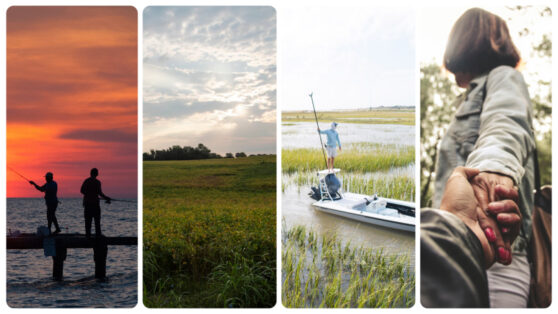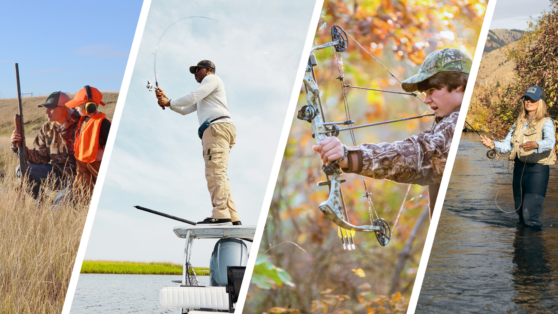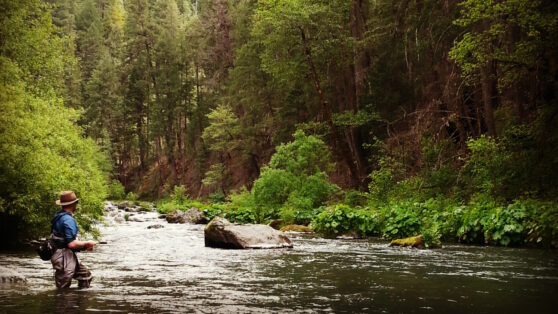How hunters and anglers can play a major role in advocating for habitat‑driven climate change solutions.
Scroll to learn more about TRCP’s climate work.
But healthy habitat can help to slow and reverse these effects, making the push for conservation and restoration more relevant than ever. Sportsmen and sportswomen are essential to securing these solutions.
How can hunters and anglers stand up for solutions that keep habitat working for wildlife and our climate?
Some believe that climate change won’t have an impact for years to come—sadly, this isn’t the case. We’ve compiled 10 ways that climate change is already affecting your hunting and fishing. Download our guide to learn more.
By maintaining, managing, restoring, and improving our lands and waters, we can make habitat work hard for more than just fish, wildlife, and our hunting and fishing opportunities.
Healthy habitats absorb and store carbon from the atmosphere, where it would otherwise contribute to global warming. Natural climate solutions—those that use the power of habitat—also lessen the impacts of climate change by reducing erosion, preventing wildfires, enhancing soil health, protecting against drought and flooding, cooling stream temperatures, strengthening coastlines, and improving the quality and availability of clean water.
Hunters and anglers stand behind habitat-driven climate solutions, of which there are two broad categories: One where work is done to enhance habitat and another where healthy habitat is left alone—and, in some cases, defended from the threat of development—to work hard against climate change.
Nowhere are these efforts more relevant than in Louisiana and Alaska. Both states are at ground zero for climate change impacts, but they also boast impressive examples of these two broad categories of nature-based climate solutions at work.
Approach #1
Example: Plaquemines Parish, Louisiana
Continually battered by hurricanes that climate change has made more intense, Louisiana has shrunk by 2,000 square miles over the last century, as sea-level rise, erosion, and severe storms combined to accelerate land loss and conversion of wetlands to open water. The absence of these coastal wetlands, marshes, and swamps has meant less breeding, spawning, feeding, and nursery habitat for fish, shellfish, waterfowl, and other wildlife. Wetlands are also needed to help reduce inland flooding and erosion and lessen hurricane effects.
Restoring, rebuilding, and reconnecting wetlands to the life-giving Mississippi River has been critical to reducing climate change impacts while benefiting fish and wildlife. Areas like Bay Denesse, in Plaquemines Parish, are being revitalized by diverting river water, sediment, and nutrients that rebuild marsh habitat and wetlands. Meanwhile, efforts to construct terraces of land and fill them in with native plants have brought wildlife and even native trees back to the landscape. The TRCP and our partners are advocating for and implementing these local projects that literally create habitat—often in areas of public land that are open to hunting and fishing.
Approach #2
Example: Southeast Alaska
Alaska is warming faster than any U.S. state, with profound impacts to fish and wildlife habitat. Milder winters and warmer summers have resulted in habitat loss, the proliferation of invasive species, and shifting migration patterns that are forcing hunters, anglers, and subsistence harvesters to adapt. Alaska’s forests, coastal and interior wetlands, and tundra and alpine systems offer some of our most powerful climate mitigation tools: the natural ability of these northern habitats to store carbon.
In Southeast Alaska, our largest national forest plays an important role in buffering the effects of climate change. The Tongass—a 17-million-acre coastal temperate rainforest—holds more than 40 percent of all the carbon stored by national forests in the U.S. Old-growth forests in the Tongass also provide ideal habitat for salmon and Sitka black-tailed deer, two of the region’s most important food sources. These hardworking, mature forests can’t provide climate or habitat benefits if they are opened to industrial development. That’s why the TRCP and many diverse stakeholders are working to restore policies that provide conservation safeguards in the Tongass.
Nature-based solutions are as diverse as the landscapes and waters where we hunt and fish, and projects to improve climate change resilience are already underway across the country. Here are six examples.
Carbon sequestration through the management and preservation of healthy soil, grasslands, wetlands, and forests on farm and ranch lands
Reforestation, stewardship of late-successional forests, and sustainable management of working forests
Restoration and conservation of rangelands, grasslands, and sagebrush—particularly native grasses and unfragmented landscapes—which store large volumes of carbon
Reducing greenhouse gas emissions, ocean warming, and acidification while restoring and employing wetlands, living shorelines, barrier islands, mangroves, and oyster reefs to reduce the impacts of extreme weather on habitat
Nutrient reduction, riparian zone improvements, enhanced connectivity, healthier floodplains, and conservation of our nation’s rivers, lakes, and streams
Enhance and, in some cases, rebuild inland and coastal wetlands to maximize flood and storm protection, carbon storage, and habitat benefits
See these concepts come to life in our nature-based solutions project map below.
It will take an all-of-the-above approach to solve climate change. While other experts focus on lowering emissions, transitioning to cleaner infrastructure, and implementing technologies to directly capture carbon, the TRCP is using our expertise to advocate for natural climate solutions in the federal policy arena.
This work includes
It’s the TRCP’s stance that climate change is human-driven. While this idea may continue to provoke controversy, the nature-based solutions we’re pushing for should not. Hunters and anglers do believe that we can positively impact fish and wildlife habitat through human intervention—and that’s what we’re calling on decision-makers to support.
We’re leading a coalition of conservationists to develop and advocate for policies that advance nature-based solutions.
Learn MoreWe were among the hunting and fishing groups who originally embraced this difficult work more than a decade ago and contributed to the publication of two groundbreaking reports that highlight the real challenges our fish and wildlife face as the climate changes.
Download Seasons' End Download Beyond Seasons' EndTiffany Turner joined our team as director of climate solutions in February 2021. Tiffany is leading our work to build broad support for systems that better connect science with policy action.
Meet Our TeamVisit our blog for more information on TRCP’s recent climate work.
Hunters and anglers have an important role to play in advocating for natural climate solutions—projects that create more carbon storage and ecosystem resilience by improving habitat. The good news is that most sportsmen and sportswomen are bought in and ready to take action against climate change.
In a 2022 national poll of hunters and anglers, 72 percent believe that climate change is happening and, of those individuals, 74 percent believe that humans play at least some role in the warming of the globe.
A majority of sportsmen and sportswomen also agreed that climate change will affect their ability to hunt and fish (or their children’s) one day, and 19 percent saw climate change as having an impact right now.
and we’ll send you the full poll results
Get involved now by sharing what you’re seeing and committing to solutions. It’s easy—first, answer two of our poll questions to see where you stand among other hunters and anglers. Then take action to push your decision-makers to secure nature-based solutions.
Take action in support of nature-based solutions to reverse climate change while benefiting our hunting and fishing opportunities.

Four bills exemplify how Congress can safeguard natural resources and protect the future of hunting and fishing in 2024.
Read More
Your support helped make these conservation successes possible.
Read More
Answers to the most frequently asked questions we hear from decision-makers, business leaders, social media users, and TRCP members.
Read MoreTheodore Roosevelt’s experiences hunting and fishing certainly fueled his passion for conservation, but it seems that a passion for coffee may have powered his mornings. In fact, Roosevelt’s son once said that his father’s coffee cup was “more in the nature of a bathtub.” TRCP has partnered with Afuera Coffee Co. to bring together his two loves: a strong morning brew and a dedication to conservation. With your purchase, you’ll not only enjoy waking up to the rich aroma of this bolder roast—you’ll be supporting the important work of preserving hunting and fishing opportunities for all.
Learn More

